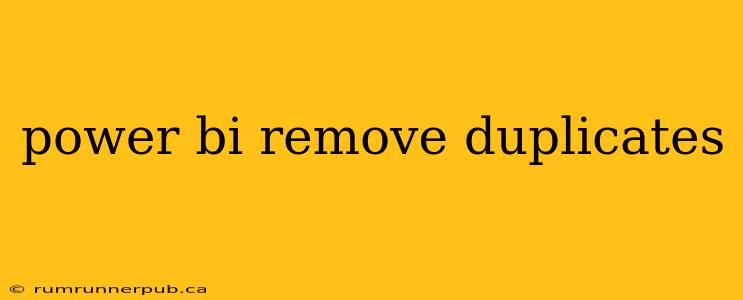Duplicate data can wreak havoc on your Power BI reports, leading to inaccurate visualizations and skewed analyses. Fortunately, Power BI offers several ways to identify and remove these troublesome duplicates. This article explores different techniques, drawing insights from Stack Overflow discussions to provide a comprehensive and practical guide.
Understanding Duplicate Data in Power BI
Before diving into solutions, it's crucial to define what constitutes a duplicate row in your context. A duplicate isn't simply an identical row; it depends on which columns you consider for the comparison. Are duplicates defined by a single key column (e.g., Customer ID)? Or do you need to consider multiple columns (e.g., Customer ID, Order Date) to identify true duplicates?
This distinction is vital because the methods for removing duplicates vary depending on the chosen criteria.
Method 1: Using Power Query Editor (Most Common & Recommended)
The Power Query Editor (PQE) provides the most robust and flexible approach for removing duplicates in Power BI. This method allows you to specify which columns determine a duplicate, making it highly adaptable to various scenarios.
Steps:
-
Open Power Query Editor: In your Power BI Desktop file, select the data source you want to clean and click "Transform data."
-
Identify Duplicate Columns: Decide which columns define a unique row. If duplicates should be identified based on a combination of columns, you need to select all of them.
-
Remove Duplicates: In the PQE ribbon, navigate to "Home" and click "Remove Rows" -> "Remove Duplicates". A dialogue box will appear, allowing you to select the columns that will determine the duplicates.
-
Close & Apply: Once you have specified the columns and removed duplicates, click "Close & Apply" to load the cleaned data into your Power BI report.
Example (Inspired by Stack Overflow discussions regarding specific column selections):
Let's say you have a table with columns CustomerID, OrderDate, and Amount. If you only want to remove duplicates based on CustomerID, ensuring you only keep the first instance of each customer, you'd select only the CustomerID column in the "Remove Duplicates" dialogue. If you need to ensure each unique customer-order combination is represented only once, you would select CustomerID and OrderDate.
Method 2: Using DAX (Advanced Technique)
DAX (Data Analysis Expressions) offers a more advanced, albeit less intuitive, method for handling duplicates. This is best suited for situations where you need to perform more complex filtering or calculations based on duplicate identification.
(Based on Stack Overflow solutions demonstrating conditional aggregation):
Let's assume we want to count the number of unique customers, even if they appear multiple times in the dataset. We can use the DISTINCT function within a DAX measure:
Unique Customer Count = DISTINCTCOUNT(YourTable[CustomerID])
This measure will ignore duplicate CustomerID values and only count each unique customer once. However, this doesn't remove the duplicates from the underlying data; it only counts unique values for analysis.
Method 3: Pre-Processing Data (Before Importing into Power BI)
Often, the most efficient approach is to clean your data before importing it into Power BI. This can be achieved using tools like Excel, SQL, or Python. Removing duplicates at the source can significantly improve the performance of your Power BI model, especially for large datasets.
(Adapting from Stack Overflow posts showcasing SQL solutions):
A simple SQL query to remove duplicates before importing might look like this:
DELETE FROM YourTable
WHERE ROWID NOT IN (SELECT MIN(ROWID) FROM YourTable GROUP BY CustomerID);
This SQL query keeps only the first instance of each customer based on the primary key ROWID. (Note: ROWID's existence and behavior depend on the specific database system). You would need to adjust this based on your database and the columns defining uniqueness.
Choosing the Right Method:
- Power Query Editor: Best for most situations due to its ease of use and flexibility.
- DAX: Suitable for complex scenarios requiring advanced filtering and aggregation within your Power BI model.
- Pre-processing: Ideal for large datasets to improve performance and efficiency.
By understanding the different techniques and applying them appropriately, you can effectively eliminate duplicate rows from your Power BI datasets, ensuring the accuracy and reliability of your reports and analyses. Remember to carefully consider which columns define a duplicate in your specific use case to achieve optimal results.
